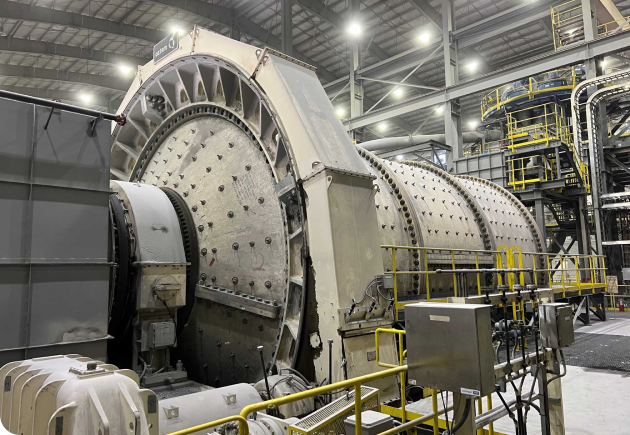Our SAG Mills provide critical grinding solutions for mineral processing across the globe. Explore our robust, efficient systems designed to maximize productivity and optimize ore reduction.
SAG Mills are integral for enhancing grinding efficiency in the mining industry, crucially optimizing ore reduction. Their combined use of grinding media and ore as grinders supports high productivity and cost-effective mineral processing.
SAG Mills utilize a dynamic grinding process involving a mix of ore and steel balls within a rotating drum to optimize particle reduction. This method ensures efficient mineral breakdown, enhancing throughput and overall processing productivity.
Metso delivers comprehensive services and premium parts for SAG mills, ensuring enhanced performance and reliability. Their offerings include inspections, maintenance, upgrades, and custom life cycle services designed for operational excellence.

SAG (Semi-Autogenous Grinding) Mills, crucial for efficient ore reduction, combine grinding media like steel balls with the ore itself in a rotating drum to optimize mineral processing. Designed to handle varying feed sizes and types of minerals, these mills enhance grinding efficiency and mineral recovery. By striking a balance between impact and attrition, SAG mills not only reduce particle size but also increase the productivity and cost-effectiveness of mining operations, making them a staple in the mining industry.
SAG Mills operate by using a combination of grinding media and the ore itself to achieve effective ore reduction. Inside these mills, a rotating drum propels the steel balls and ore particles to collide and grind against each other. This semi-autogenous grinding process leverages the kinetic energy from the falling media and ore, which are mixed to enhance the grinding process, achieving finer particle size with each rotation. Carefully designed components manage the dynamics within the mill, ensuring optimal grinding conditions and protecting the structure from potential damage due to the intense mechanical stresses involved. This operational mechanism not only boosts grinding efficiency but also contributes to a higher throughput in mineral processing.


Metso is renowned for its high-performance SAG (Semi-Autogenous Grinding) mills, leveraging over a century of engineering expertise. Metso’s SAG mills are designed for efficient grinding, durability, and minimal downtime, ensuring superior operational performance.
Metso provides an extensive range of services tailored for SAG mills, including:
Metso supplies premium parts for SAG mills, such as:
Metso is committed to continuous improvement, offering upgrades and optimizations that enhance performance, reduce costs, and increase sustainability of SAG mills.
For further information, visit Metso’s Grinding Mill Services

SAG Mills are primarily used in the mining sector to grind ores like copper, gold, and iron to prepare them for further processing. However, their use extends beyond metal mining, as they are also found in other mineral processing applications such as the production of aggregates and cement. The ability of SAG Mills to handle large and variable size materials makes them invaluable in the primary grinding phase, where consistency and efficiency are key to optimizing downstream processes. Their robust nature allows them to perform in continuous operation, which is essential in high-throughput industries.
SAG Mills offer a distinct advantage over other types of grinding mills, such as Ball Mills and Rod Mills, due to their ability to use larger pieces of ore as grinding media. This not only reduces the need for additional grinding material but also enhances the efficiency of the grinding process. While Ball Mills rely on the extreme finesse of steel balls to achieve a similar grind, SAG Mills can achieve adequate grind with coarser materials, leading to lower energy consumption and operational costs. Furthermore, the flexibility in feed size and output makes SAG Mills particularly attractive in varying ore conditions compared to more traditional mills, which may require more pre-processing of the material.


The primary advantages of SAG Mills include their ability to handle large and variable sizes of feed efficiently, which translates into a reduction in the overall time and energy required for grinding processes. This capability allows for a significant reduction in the costs associated with wear and tear on the equipment, as well as energy consumption. Moreover, SAG Mills enhance the overall yield of a mineral processing operation by optimizing the grinding efficiency and ensuring a consistent particle size, which is crucial for the subsequent beneficiation stages. The reduced operational complexities and enhanced throughput also make SAG Mills a preferred choice for expanding existing operations or developing new mining projects.
Grinding mills are common in mineral processing and come in various types, each suited to specific applications and material characteristics. SAG Mills, part of the larger family of semi-autogenous and autogenous mills, offer a blend of the best characteristics of both types. Autogenous Mills, for example, do not require grinding media as the ore itself acts as the grinding media. On the other hand, Ball Mills use small grinding media, typically made from steel, ceramic, or other hard materials.
In addition to these, Rod Mills are also closely related and utilize long rods for grinding media, which are particularly effective for grinding mineral ores to a size suitable for the downstream process. The choice between these mills often depends on the feed size, the mineralogical characteristics of the ore, and the required product size. Each type of mill, including SAG Mills, is designed with specific operational goals in mind, such as maximizing grinding efficiency, minimizing energy consumption, and optimizing the liberation of valuable minerals.
